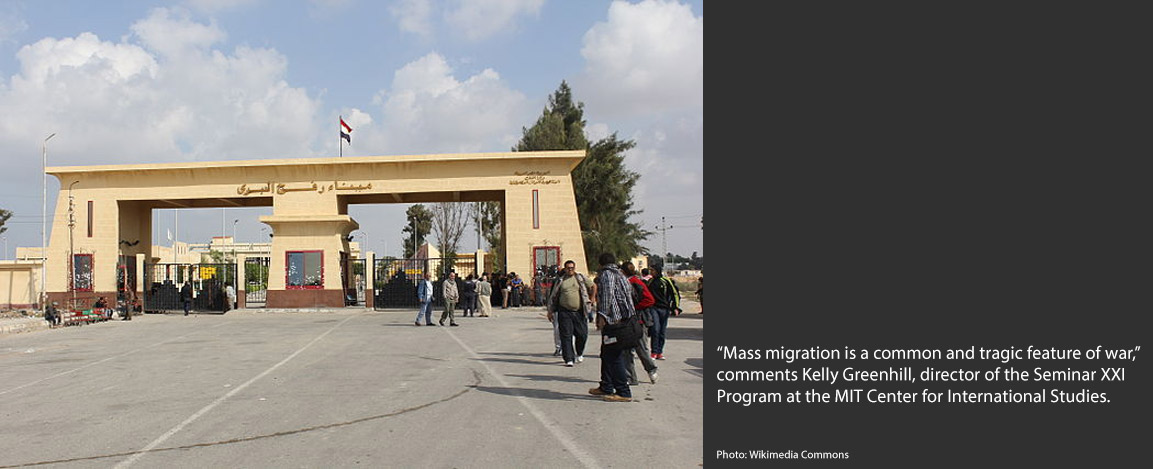Kelly M Greenhill, director of the Seminar XXI Program at CIS, was interviewed in Good Authority on how mass migration can be used as a tool of war and how we can understand the current migration crisis in Gaza. "This will be an especially difficult situation to mitigate, including but not limited to the human toll of migration," she says. An excerpt is featured below.
Hamas’ attack on Israel and the Israeli response have trapped civilians in Gaza in a humanitarian crisis. Last week, Israel issued a warning to those living in Gaza to head south, initially giving them only 24 hours. Although Israel later eased the deadline, the threat and the expected Israeli military incursion into Gaza have left the civilian population needing to go somewhere and with only one possible route out of Gaza: through Egypt, whose government has said it will not take any refugees.
How should we think about this huge potential population movement? I asked Kelly M Greenhill, author of the book Weapons of Mass Migration (a second, expanded and updated edition is forthcoming), to explain how mass migration can be a tool of war.
1. What makes mass migration a weapon?
Mass migration is a common and tragic feature of war. Many people think of it as an unintended consequence of conflict, as people flee for their lives, from guns, tanks, and artillery on the ground and from bombs and missile strikes from the air. This conventional wisdom is correct, but incomplete.
In many cases, mass migrations are the result of deliberate and calculated actions, designed, engineered, and executed to achieve strategic ends. Some of my research focuses on these intentionally generated and exploited migrations, which I refer to as strategically engineered migration, or SEM.
Strategically engineered migration is a broad phenomenon in which governments or non-state actors – organizations and/or individuals that are not affiliated with, directed by, or funded by any government – deliberately create, impede, or manipulate population inflows or outflows, or simply threaten to do so, to achieve political, economic and/or military aims.
There are four main types of SEM, all of which are common features of international politics, in times of war as well as periods of peace.
First, in coercive engineered migration, cross-border population movements are deliberately created, impeded, manipulated, or simply threatened in order to induce political, military, and/or economic concessions from a target state or states. As I detail in my book Weapons of Mass Migration, unlike in traditional military coercion, in coercive engineered migration (CEM), costs and punishments are inflicted through the threat and actual use of “people pressure” to achieve goals that often would be unattainable or too costly to pursue through military means. While the targets of this type of coercion are typically governments, the real victims of this kind of coercion are the displaced people who are used as bargaining chips or weapons.
For instance, when former Libyan leader Moammar Gaddafi threatened to “turn Europe black” and “Muslim” by flooding the continent with migrants if not provided with billions of Euros and a variety of other concessions, he was engaged in this kind of coercion. (In the first decade of the 2000s, Gaddafi successfully used CEM on multiple occasions against the E.U. and against individual European countries before fatally overplaying his hand in early 2011, resulting in his ouster from power and death.) Turkish President Recep Tayyip Erdoğan has likewise repeatedly threatened to flood Europe with (mostly Syrian) refugees and other migrants over the last decade. One such coercive episode resulted in the much-maligned 2016 E.U.-Turkey deal.
Second, in dispossessive engineered migration, governments or non-state actors use forced migration to seize the territory or property of the displaced or to eliminate the displaced population as a political or economic threat to the dominance of the group engineering the migration. This class of events includes what is commonly known as “ethnic cleansing.” Disposessive engineered migration (DEM) was a common feature of the wars in the Balkans in the 1990s, following the collapse of Yugoslavia. It is also, according to allegations made by the United Kingdom, currently happening in the Darfur region of Sudan.
Third, in exportive engineered migration (EEM), the goal is to strengthen a government’s domestic political position by expelling dissidents or to discomfit, humiliate, or (in extremis) destabilize a foreign government or governments. This is most likely what President Aleksandr Lukashenko’s regime was up to on the border between Belarus and the E.U. (in Poland, Lithuania, and Latvia) in the fall and winter of 2021. Evidence suggests that, at a minimum, Lukashenko sought to embarrass the E.U., knowing its members were unlikely to welcome the migrants and asylum seekers he’d enticed to Belarus from Iraq, Afghanistan, and elsewhere, and transferred to its borders with the E.U. Lukashenko likely also aimed to punish the E.U. for its criticism of his regime’s human rights record, for its unwillingness to declare him the legitimate winner of the country’s dodgy 2020 presidential election, and for imposing new sanctions on Belarus after the aforementioned disputed election.
Fourth, and finally, militarized engineered migration (MEM) is often used in the midst of armed conflict to gain military advantage against an adversary, via the disruption or destruction of an opponent’s command and control, logistics, or movement capabilities, or to enhance one’s own force structure. All parties to the Syrian civil war have used MEM (as well as DEM) to impede their adversaries and boost their own military strength to some degree, for instance. The Syrian government’s intense shelling of civilian targets that swiftly displaced another 70,000 in a rebel-held area of northwest Syria last week is just one recent probable example of this tool in action.
Read the full article here.




